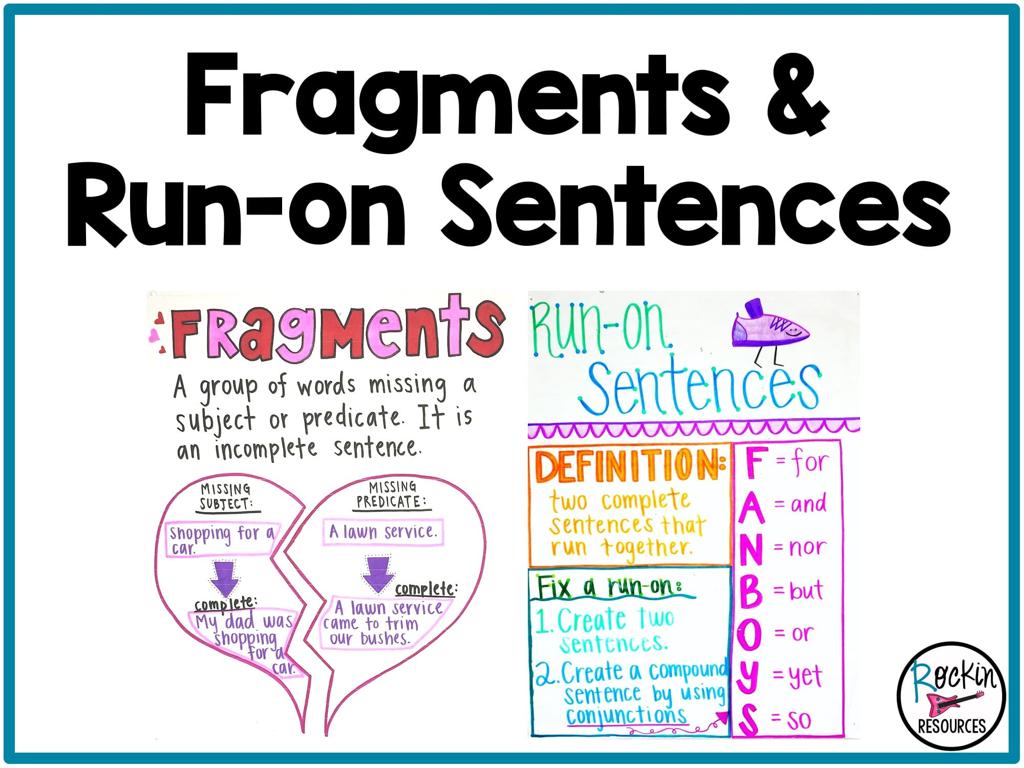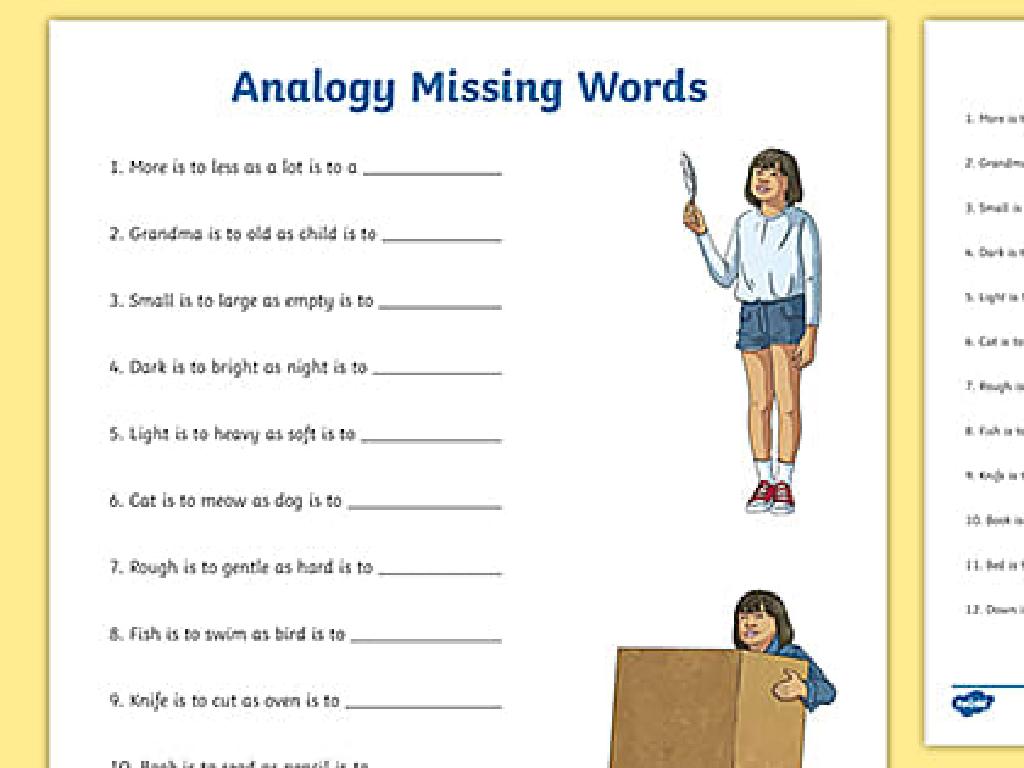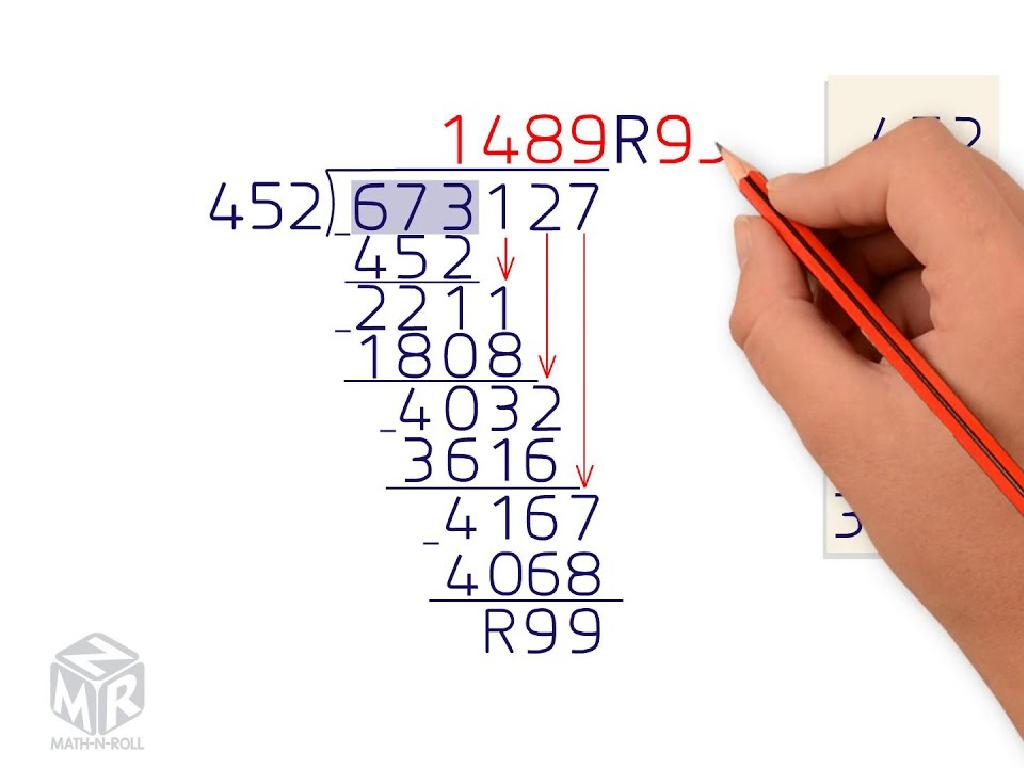Identify The Graph Of An Equation
Subject: Math
Grade: Seventh grade
Topic: Two-Variable Equations
Please LOG IN to download the presentation. Access is available to registered users only.
View More Content
Identifying the Graph of an Equation
– Relationship between variables
– Variables can be independent or dependent
– Graphing equations introduction
– A visual representation of equations on a coordinate plane
– Focus: Graph identification
– Learn to match equations with their graphs
– Practice with examples
– Use sample equations to draw and recognize graphs
|
This slide introduces the concept of identifying the graph of an equation within the broader topic of two-variable equations. Start by explaining how variables interact with each other, with one often depending on the value of the other. Introduce graphing as a method to visualize these relationships. Emphasize the day’s goal: to be able to look at an equation and understand what its graph looks like. Provide practice examples where students can apply this knowledge by drawing graphs based on given equations and identifying graphs from a set of options. This will help solidify their understanding of how equations are represented visually.
Understanding Equations in Math
– Define an equation
– An equation is a statement that two expressions are equal, involving numbers and variables.
– Two-variable equation examples
– Examples: y = 2x + 1, 3x – 5y = 12
– Equations show quantity relationships
– They express how one quantity changes in relation to another.
– Graphing equations
|
Begin the lesson by defining an equation as a mathematical statement that asserts the equality of two expressions. Provide examples of two-variable equations to illustrate the concept. Explain that equations are used to represent relationships between different quantities; for instance, how one variable may increase as another decreases. Emphasize the importance of understanding these relationships as they form the basis for graphing equations on a coordinate plane. Encourage students to think of real-life situations that could be modeled by two-variable equations, such as the relationship between distance and time, or savings and interest rates.
The Coordinate Plane
– X and Y axes explained
– The X-axis is horizontal, Y-axis is vertical
– Points as ordered pairs
– Each point is defined by (x, y) showing position
– Quadrants on the plane
– The plane is divided into four quadrants
– Graphing equations
– Plot points to represent equations visually
|
Begin with an introduction to the coordinate plane, explaining the horizontal X-axis and the vertical Y-axis. Emphasize that the intersection of these axes is the origin (0,0). Teach students how to identify points on the plane using ordered pairs (x, y), where ‘x’ is the position along the X-axis and ‘y’ is the position along the Y-axis. Explain the concept of quadrants, the four sections created by the axes, and how they are numbered using Roman numerals I, II, III, and IV. Lastly, demonstrate how equations can be represented graphically by plotting points that satisfy the equation and connecting them to form a line or curve. This visual representation helps students understand the relationship between algebraic equations and their graphical counterparts.
Plotting Points on the Coordinate Plane
– Plot points using ordered pairs
– Each pair (x, y) corresponds to a unique point
– Class activity: practice plotting
– Use graph paper to plot points as a class
– Locate points in quadrants
– Quadrants are numbered I to IV starting top right and moving counter-clockwise
– Understanding coordinates
|
Begin by explaining the concept of ordered pairs and how each pair represents a point on the coordinate plane. Demonstrate plotting a point using an example like (3, 2). Organize a class activity where students practice plotting points on graph paper, which will help solidify their understanding. Discuss the Cartesian plane’s four quadrants and how they are numbered, ensuring to highlight the positive and negative values of x and y in each quadrant. Emphasize the importance of precision when plotting points. For students who grasp the concept quickly, challenge them with points that lie on the axes or the origin.
Graphs of Two-Variable Equations
– Equations as graphs
– Each equation can be visualized as a graph on a coordinate plane.
– Types of lines on graphs
– Lines can be straight (linear) or curved (non-linear).
– Understanding slope
– Slope measures steepness: rise over run.
– Exploring y-intercept
– Y-intercept is where the line crosses the y-axis.
|
This slide introduces students to the concept of representing equations graphically. Emphasize that every equation can be translated into a visual format, which helps in understanding the relationship between variables. Discuss the different types of lines that can appear on a graph, such as straight lines for linear equations and curves for quadratic or higher-order equations. Explain the concept of slope as a measure of how steep a line is, and introduce the y-intercept as the point where the line crosses the y-axis. Use examples like y=2x+3 to illustrate a positive slope and y-intercept. Encourage students to practice by plotting graphs and identifying slopes and y-intercepts from given equations.
Graphs of Two-Variable Equations
– Match equations with graphs
– How equation changes affect graphs
– Altering coefficients/variables transforms the graph’s slope and intercept
– Example: y = 2x
– Straight line, slope of 2 through origin
– Example: y = x + 3, y = -x
– y = x + 3: line with slope 1, y-intercept at 3; y = -x: line with slope -1 through origin
|
This slide aims to help students visualize how different two-variable linear equations are represented graphically. Start by explaining that each equation corresponds to a unique line on the graph. Show how changing the equation’s coefficients or constants can tilt the line (change its slope) or move it up and down (change its y-intercept). Use the examples to illustrate positive, negative, and varying slopes. Encourage students to draw these lines on graph paper, noting how ‘y = 2x’ doubles the value of ‘y’ for every ‘x’, creating a steeper line, while ‘y = x + 3’ shifts the line three units up on the y-axis. Discuss how ‘y = -x’ reflects across the origin, creating a downward slope. This will prepare them for more complex functions and deepen their understanding of linear relationships.
Class Activity: Graphing Equations
– Receive a worksheet with equations
– Plot equations on coordinate plane
– Use graph paper to mark points and draw lines
– Class review of graphed equations
– Discuss the characteristics
– Look for patterns like linearity or curvature
|
This class activity is designed to help students understand the relationship between algebraic equations and their graphical representations. Each student will be given a worksheet containing various two-variable equations. They will use graph paper to plot these equations on a coordinate plane, marking points that satisfy the equation and connecting them to reveal the graph. After completing the activity, the class will come together to review the different graphs. This will be an interactive session where students can compare their results and discuss the characteristics of each graph, such as slope, intercepts, and shape. The teacher should prepare different types of linear and non-linear equations to ensure a comprehensive understanding of the topic. Possible variations for different students could include equations with different slopes, y-intercepts, or complexities (e.g., quadratic equations). The teacher should circulate during the activity to provide guidance and ensure that students are plotting points accurately.
Real-Life Applications of Graphs
– Graphs in business and science
– Stock market trends, scientific data visualization
– Benefits of understanding graphs
– Analyzing trends, making predictions
– Student-generated examples
– Think of times you’ve seen graphs outside of school
– Graphs as decision-making tools
– Choosing products, planning experiments
|
This slide aims to show students the practical applications of graphs in everyday life, particularly in business and science. Discuss how graphs are used to track stock market trends or to visualize scientific data. Emphasize the importance of understanding graphs to analyze information, make informed decisions, and predict future trends. Encourage students to think of examples where they have encountered graphs outside of school, such as in advertisements, weather reports, or sports statistics. Explain how graphs serve as vital tools for decision-making in various fields. For the activity, students can brainstorm and share examples of graphs in real life, fostering a deeper connection between mathematical concepts and their world.
Wrapping Up: Graphs of Equations
– Recap: Identifying graph of an equation
– Importance of regular practice
– Homework: Graphing worksheet
– Complete the provided worksheet by graphing each equation.
– Keep practicing at home!
– Practice helps reinforce today’s lesson and prepares for the next class.
|
As we conclude today’s lesson, it’s crucial to emphasize the key points we’ve covered about identifying the graph of an equation. Remind students that understanding the relationship between equations and their graphical representations is fundamental in algebra. The homework assignment is a worksheet that requires students to apply what they’ve learned by graphing various two-variable equations. Encourage them to take their time with each problem and to check their work. Regular practice is essential for mastery, and this worksheet will help solidify their understanding. In the next class, we will review the homework and address any questions or difficulties the students may have encountered.
Class Activity: Graphing Relay
– Students form groups
– Each group graphs an equation
– Use graph paper/board to plot points
– First correct graph wins
– Accuracy and speed are key
– Discuss winning strategy
– Share insights on the approach taken
|
Divide the class into small groups and assign each group a different two-variable equation to graph. Provide each group with markers and access to the board to draw their graph. The goal is to correctly plot the graph of their assigned equation before the other groups. Ensure that all students understand how to find and plot points on a graph. After the activity, discuss the winning group’s strategy and what made their approach effective. This will reinforce their understanding of graphing equations and encourage teamwork. Possible variations of the activity could include timed rounds, complex equations, or a gallery walk where students critique each other’s graphs.






